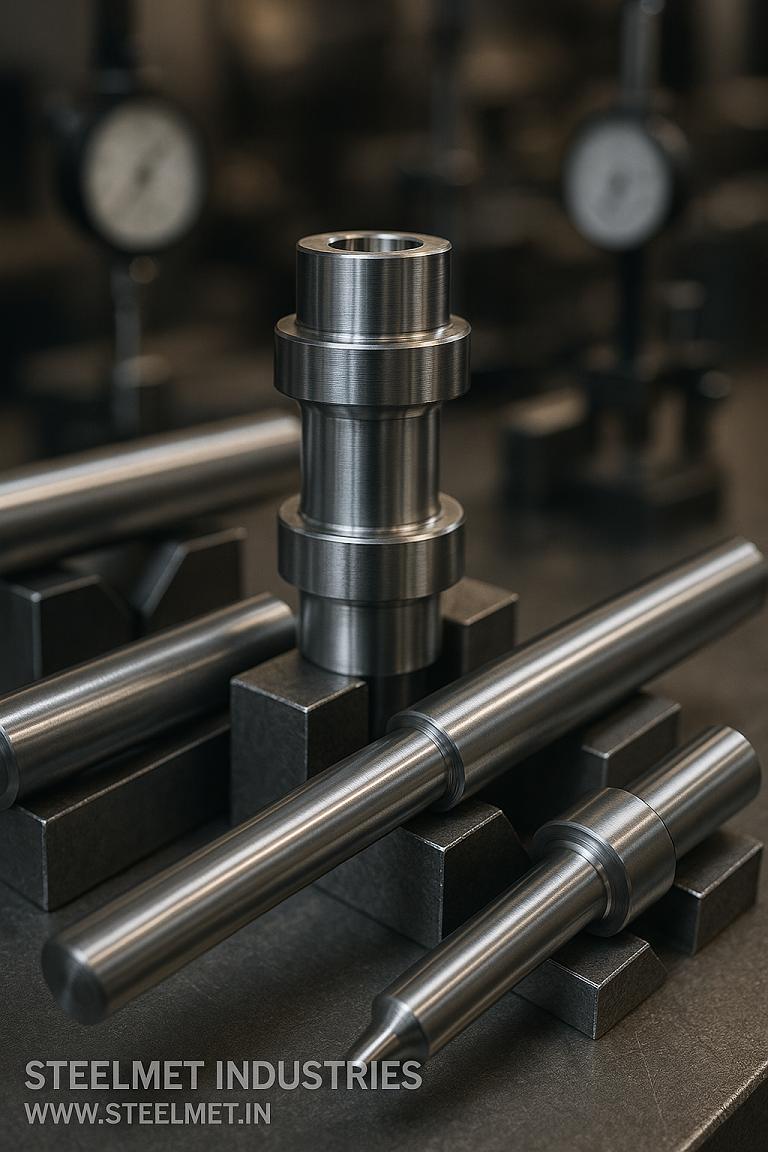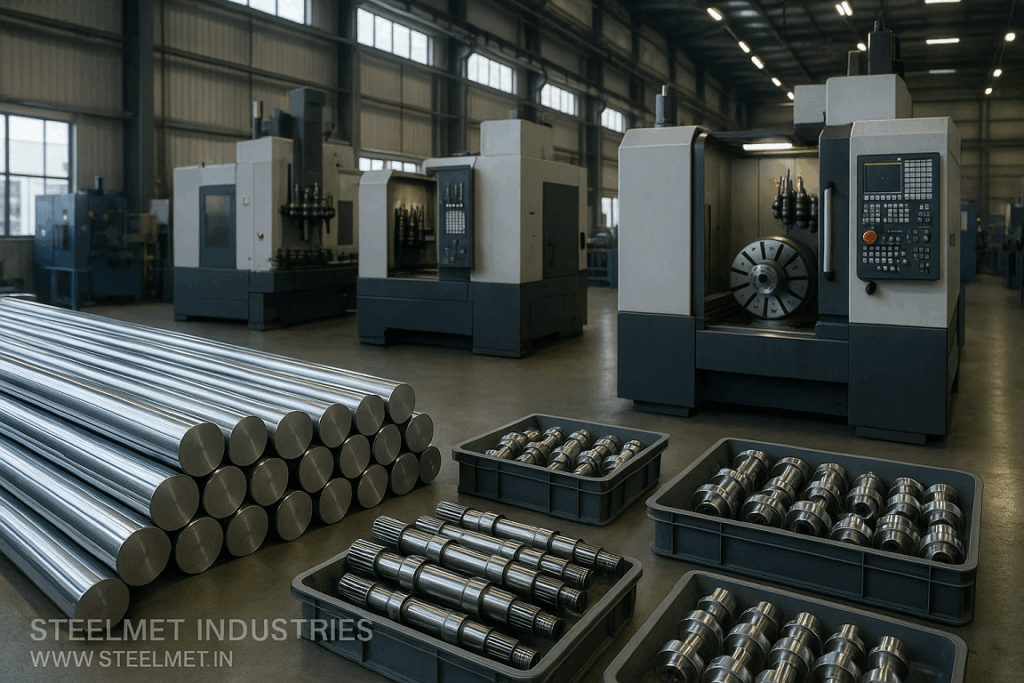Bright Steel Bars for Industrial Machinery Components
Industrial machinery components require repeatable precision, long wear life and predictable mechanical behaviour under continuous operation. Bright steel bars supply the dimensional accuracy, clean surface condition and consistent metallurgy needed for shafts, spindles, rollers, couplings and guide elements used in packaging, material-handling, machine tools and automated equipment.

Bright bars prepared for machining into shafts, rollers and precision industrial components.
Primary Uses in Industrial Machinery
- Drive shafts, spindles and transmission shafts
- Rollers, conveyor shafts and material-handling spindles
- Guide rods, pillars and linear-motion components
- Couplings, sleeves, bearing-fit parts and bushings
- Machine-tool spindles, mandrels and precision pins
- Valve stems, actuators and indexing components
Component Types & Typical Demands
Precision Shafts & Spindles
Shafts and spindles require high concentricity, low runout and uniform surface finish to enable accurate rotation, minimise vibration and protect bearings. Bright bars reduce grinding waste and lower balancing requirements on finished components.
Rollers & Conveyor Components
Conveyor rollers and material-handling shafts need consistent diameter, uniform hardness (after heat treatment) and minimal eccentricity to avoid tracking issues and premature bearing wear.
Couplings, Sleeves & Bushings
Interference fits, bearing seats and sleeves depend on accurate OD/ID tolerances and low surface defect density. Bright bars help ensure predictable interference fits and easier assembly.
Guide Rods & Linear Motion Components
Guide rods and linear-motion elements require polished surfaces, controlled hardness and fatigue resistance to maintain precision over long production runs and reduce maintenance intervals.
Why bright bars improve machine performance
- Reduced runout and improved concentricity lower vibration and extend bearing life.
- Better surface finish minimises friction and improves sealing performance in assemblies.
- Consistent chemistry and microstructure enable repeatable heat-treatment outcomes across batches.
- Lower machining allowances reduce cycle times and tool consumption for high-volume parts.
Real-world use case
Example: A packaging OEM using bright C45 shafts for conveyor rollers achieved a measurable decrease in bearing replacements. Switching from hot-rolled to bright-bar starting material reduced final grinding by 30% and improved roller runout consistency, leading to fewer line stoppages and lower lifetime operating cost.
Quick decision pointers
- For precision spindles and machine-tool shafts: select EN24/4340 or EN19/4140 depending on speed and load; specify controlled hardening and balance tolerances.
- For conveyor rollers: use case-hardened grades where sliding wear is expected or EN31/52100 for rolling-contact applications.
- For guide rods: prefer fine-grain steels with good polishability and nitriding compatibility for low-friction surfaces.
- For interference-fit bushes and couplings: specify OD/ID tolerances and surface finish requirements to avoid assembly rework.
Failure-prevention and quality notes
- Specify straightness tolerance per unit length for long shafts; uncontrolled bowing leads to bearing misload and accelerated wear.
- Define surface roughness (Ra) for bearing journals and guide surfaces to ensure lubricant film formation and seal life.
- Control residual stresses introduced by drawing or cold working—stress relief or stabilizing anneals may be required for precision parts.
- Include batch microstructure or inclusion limits for high-cycle fatigue components to reduce crack initiation risk.
Standards & Equivalents (Table 1)
| IS | BS970 | AISI / SAE | DIN / EN | JIS | GOST | GB |
|---|---|---|---|---|---|---|
| C40 / C45 | EN8 | 1040 / 1045 | C45E / 1.1191 | S40C / S45C | 40 / 45 | 40# / 45# |
| EN19 | 708M40 | 4140 | 42CrMo4 / 1.7225 | SCM440 | 40Х | 42CrMo |
| EN24 | 817M40 | 4340 | 34CrNiMo6 / 1.6582 | SNCM447 | 40ХН2МА | 34CrNiMo6 |
| EN31 | 070M55 | 52100 | 1.3505 | SUJ2 | ШХ15 | GCr15 |
| 20MnCr5 | 655M20 | — | 20MnCr5 / 1.7147 | SCM420H | 20ХГ | 20CrMn |
Grade Selection, Performance & Heat Treatment (Table 2)
| Grade | Typical Application in Industrial Machinery | Performance Indicators | Typical Heat Treatment Route |
|---|---|---|---|
| C40 / C45 (1040 / 1045) | Used for general-purpose shafts, guide rods and mid-load couplings where balanced machinability and strength are required for repeatable production. | Machinability: Medium | Hardenability: Low/Medium | Wear Resistance: Moderate | Fatigue Strength: Moderate | Normalize or Q&T for improved strength; induction hardening for local wear surfaces if required. |
| EN19 (4140 / 42CrMo4) | Preferred for medium-to-high load spindles and drive shafts that require reliable Q&T response and good toughness at operating speeds. | Machinability: Medium | Hardenability: Good | Wear Resistance: High | Fatigue Strength: High | Quench & Temper (Q&T); surface induction hardening for bearing seats or contact areas. |
| EN24 (4340 / 34CrNiMo6) | Used where deep hardenability and superior fatigue resistance are required, for example high-speed spindles, heavy rollers and critical coupling shafts. | Machinability: Medium/Low | Hardenability: Excellent | Wear Resistance: Very High | Fatigue Strength: Very High | Quench & Temper; calibrated tempering or sub-zero treatments may be used to optimise fatigue life. |
| EN31 / 52100 | Ideal for rolling-contact elements, precision rollers and components requiring high contact fatigue resistance and surface hardness. | Machinability: Low | Hardenability: Excellent | Wear Resistance: Very High | Fatigue Strength: Very High | Through-hardened and tempered; bearing heat-treatment cycles applied as required for contact fatigue performance. |
| 20MnCr5 (case-hardening) | Used for splines, mating surfaces and bushings where a hard, wear-resistant case with a tough core increases service life under sliding contact. | Machinability: Medium | Hardenability: Low (designed for case) | Wear Resistance: High (after case) | Fatigue Strength: High (core) | Carburize to specified case depth then Q&T with tempering; typical case depth 0.6–1.2 mm per design requirements. |
Inspection & manufacturing checklist
- Specify runout and concentricity limits for rotating parts; provide acceptable values in drawing notes to avoid interpretational ambiguity.
- Request surface finish values (Ra) for journals and sealing surfaces to ensure correct lubrication and sealing performance.
- Include batch metallurgical certificates for critical spindles and high-cycle fatigue components.
- Where grinding is required, define maximum stock allowance and finish grinding protocols to avoid overheating and microstructural changes.
Frequently Asked Questions
Which grade is best for machine-tool spindles?
EN24 (4340) is commonly selected for high-performance spindles due to its deep hardenability and excellent fatigue resistance; precise Q&T and balance control are essential.
Are bright bars necessary for conveyor rollers?
Bright bars improve roller concentricity and reduce balancing and grinding needs. For rolling contact, consider EN31/52100 or case-hardened options depending on the wear mechanism.
How should I specify straightness for long shafts?
Define straightness per length (e.g., maximum deflection in mm per metre) on the drawing and set post-heat-treatment straightness requirements if the part will be heat-treated.
Contact for Industrial Machinery Requirements
For shafts, rollers, spindles, couplings, guide rods or special machinery components manufactured from precision bright bars:
Related: Tooling, Shafts & Transmission — Hydraulics & Pneumatics — Electric Motor Parts

